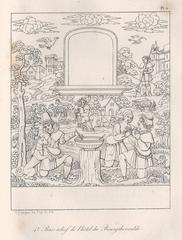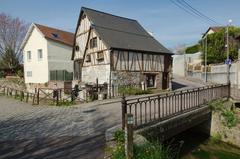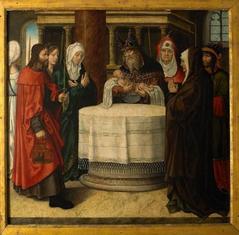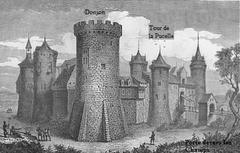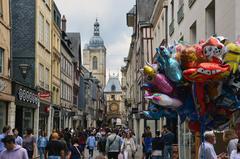
Complete Guide to Visiting Église Saint-Éloi in Rouen: Hours, Tickets, and Historical Insights
Date: 04/07/2025
Introduction
Located in the heart of Rouen, France, Église Saint-Éloi—now known as Temple Saint-Éloi—stands as an enduring symbol of the city’s layered religious legacy, architectural splendor, and vibrant cultural life. Originally founded as a medieval chapel, this monument has evolved through centuries of Gothic, Baroque, and Protestant influences, making it a must-visit for history enthusiasts, architecture lovers, and anyone seeking to explore Rouen’s rich heritage.
This detailed guide provides everything you need to know to plan your visit: from the church’s fascinating history and architectural highlights to up-to-date visiting hours, ticketing, accessibility, and practical tips. Whether you wish to attend an organ concert, admire stunning stained glass, or set out on a historical walking tour, Église Saint-Éloi offers a memorable and enriching experience. For further details and updates, consult official resources and tourism sites (Concerts Saint-Éloi, Monumentum, Normandy Tourism).
Table of Contents
- Discover Église Saint-Éloi: Why Visit?
- Historical Overview
- Architectural Highlights
- Visitor Information
- Events & Concerts
- Nearby Attractions & Suggested Itineraries
- Frequently Asked Questions (FAQ)
- Practical Tips for Visitors
- Plan Your Visit: Stay Connected
- References & Further Reading
Discover Église Saint-Éloi: Why Visit?
Église Saint-Éloi is a captivating destination for those eager to immerse themselves in Rouen’s multifaceted history. The church not only showcases remarkable Gothic and Baroque architecture, but also narrates a story of resilience—from medieval times through wars, revolutions, and religious transformations. Today, as an active Protestant temple and concert venue, it bridges the past and present, welcoming visitors of all backgrounds.
Historical Overview
Medieval Roots & Early Foundations
Founded on a small island in the Seine during the Middle Ages, the original chapel of Saint-Éloi was soon integrated into the burgeoning city through land reclamation. By the 13th century, it had grown into a full parish church, closely tied to Rouen’s ecclesiastical hierarchy and civic life (Waymarking.com).
The current building’s construction began in the late 15th century and continued into the 16th, reflecting the city’s prosperity and religious significance. The basilica plan, with its broad nave and absence of a transept, distinguishes it from other Gothic churches in Rouen (Monumentum).
Renaissance & Baroque Transformations
The 16th century brought both artistic flourishing and devastation. During the Wars of Religion, the church was extensively damaged by iconoclasm, but it was restored and expanded, culminating in the completion of its tower and rose window by 1580. In the early 18th century, architect Martinet introduced Baroque interior elements, such as Corinthian columns, a richly decorated marble chancel, and an ornate organ case (Patrimoine-Histoire).
Revolutionary Upheaval & Protestant Rebirth
The French Revolution brought secularization: Saint-Éloi was closed, repurposed as a forage store and shot factory, and stripped of many religious artifacts. Its fate changed in 1803 when Napoleon designated it for Rouen’s Protestant community, making it a rare example of a major Catholic church repurposed for Reformed worship (Wikipedia). The square outside is now named Place Martin Luther King, underscoring its symbolic role in religious tolerance.
Architectural Highlights
Exterior Features
- Facade & Tower: The church’s sober Gothic facade is marked by a restrained portal and a rose window, completed in 1580. The 16th-century tower is capped with a 17th-century timber spire clad in slate, a distinct feature in Rouen’s cityscape (Rouen-Histoire).
- Structural Layout: Église Saint-Éloi’s basilica plan features a nave of nine bays and a three-sided apse, with construction details revealing both early and late Gothic craftsmanship (France-Voyage).
Interior Treasures
- Baroque Transformation: The chancel is adorned with Corinthian columns, gilded entablatures, and a Baroque “gloire” above the altar (Guide Tourisme France).
- Stained Glass: While much was lost to iconoclasm and revolution, some Renaissance glass remains, notably in the choir. Other panels are preserved in local museums (Rouen-Histoire).
- Historic Organ: The grand Lefebvre organ (1735), with its classified case, hosts acclaimed concerts and is a highlight for music lovers (Concerts Saint-Éloi).
- Furnishings & Art: Surviving sculptures, paintings, and liturgical items reflect the church’s Catholic and Protestant history.
Visitor Information
Opening Hours & Tickets
- Hours: Generally open Tuesday to Sunday, 10:00 AM–6:00 PM. Closed Mondays and on public holidays. Hours may vary for special events.
- Tickets: Entry is free; donations are encouraged to support upkeep and programming. Some concerts may require tickets (France Voyage).
Accessibility
The main entrance is wheelchair accessible, and ramps are available. While most areas are accessible, some upper galleries may not be. For specific needs, contact the church in advance.
Getting There
- Location: Place Martin Luther King, central Rouen, near Place de la Pucelle. Walking distance from main squares and the train station (Gare de Rouen-Rive-Droite).
- Public Transport: Nearby bus lines and tram stops provide easy access.
- Parking: Use public car parks such as Parking Vieux Marché or Parking Palais de Justice. Cycling is also a good option (Normandy Tourism).
Facilities & Etiquette
- No on-site restrooms or cloakrooms, but public amenities are close by.
- Modest dress and quiet behavior are appreciated, especially during services.
- Photography is allowed (no flash/tripods). Please respect privacy during worship and events.
Events & Concerts
Église Saint-Éloi’s renowned acoustics make it a favored venue for organ recitals, choral performances, and classical concerts. Schedules are posted on-site and online; advance booking is advised for major events (Agenda Culturel). The European Heritage Days and local festivals often include special tours and events.
Nearby Attractions & Suggested Itineraries
Combine your visit with Rouen’s other landmarks:
- Cathédrale Notre-Dame: France’s tallest cathedral and a masterpiece of Gothic architecture.
- Gros Horloge: The city’s iconic Renaissance clock tower.
- Place du Vieux-Marché: Historic square linked to Joan of Arc.
- Musée des Beaux-Arts: Renowned art museum.
- Aître Saint-Maclou: Former ossuary turned arts center.
Suggested itinerary: Begin at Église Saint-Éloi, stroll to the cathedral, and explore the old town’s winding streets and vibrant markets (Just Gone Wandering).
Frequently Asked Questions (FAQ)
Q: Is there an entrance fee?
A: No, entry is free. Donations are appreciated.
Q: Are guided tours available?
A: Yes, during weekends or upon request, and during heritage events.
Q: Is the site accessible for people with disabilities?
A: The main areas are accessible; contact in advance for specific needs.
Q: Can I take photographs?
A: Yes, but avoid flash and photographing during services.
Q: How do I get there by public transport?
A: Central location with easy access by bus, tram, or on foot.
Q: Are there regular concerts?
A: Yes, especially organ recitals. Check the concert calendar.
Practical Tips for Visitors
- Plan ahead: Confirm opening hours and check for special events.
- Arrive early: For a peaceful visit and better photo opportunities.
- Language: Most information is in French; consider using a translation app.
- Weather: Rouen can be rainy—an umbrella is useful.
- Dining: Enjoy local cuisine nearby, from classic Norman fare to Michelin-starred restaurants.
- Souvenirs: While no gift shop is on-site, nearby boutiques offer local crafts and mementos.
Plan Your Visit: Stay Connected
For the latest updates, event schedules, and exclusive content, download the Audiala app and follow us on social media. Explore more guides on Rouen’s historical sites, and make sure to check digital maps and virtual tours for orientation.
Conclusion
Église Saint-Éloi is more than a monument—it is a living testament to Rouen’s centuries-old narrative of faith, resilience, and artistic achievement. Its free admission, central location, and rich programming make it an essential stop for cultural travelers and locals alike. Whether you come for history, music, or quiet reflection, visiting Église Saint-Éloi promises an inspiring and unforgettable experience.
Explore, discover, and connect with Rouen’s extraordinary heritage—Église Saint-Éloi awaits your visit!
References and External Links
- Concerts Saint-Éloi
- Monumentum
- Wikipedia: Temple Protestant Saint-Éloi de Rouen
- France-Voyage: Church Saint-Éloi, Rouen
- Rouen-Histoire: Église Saint-Éloi
- Patrimoine-Histoire: Rouen Saint-Éloi
- Guide Tourisme France: Temple Saint-Éloi, Rouen
- Waymarking.com: Temple Église Saint-Éloi Rouen France
- Just Gone Wandering: Rouen France Itinerary & Sightseeing
- Normandy Tourism: Things to See and Do in Rouen

